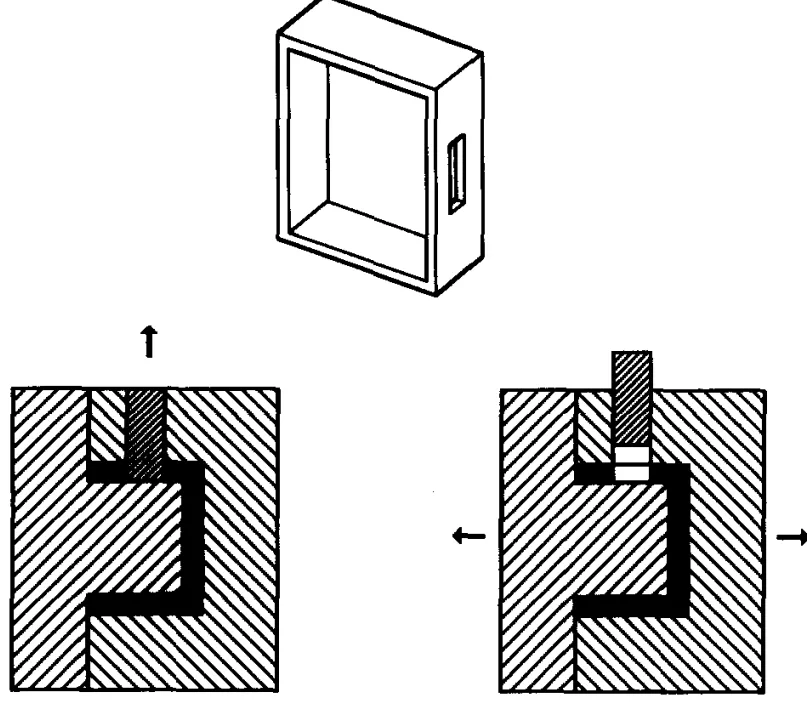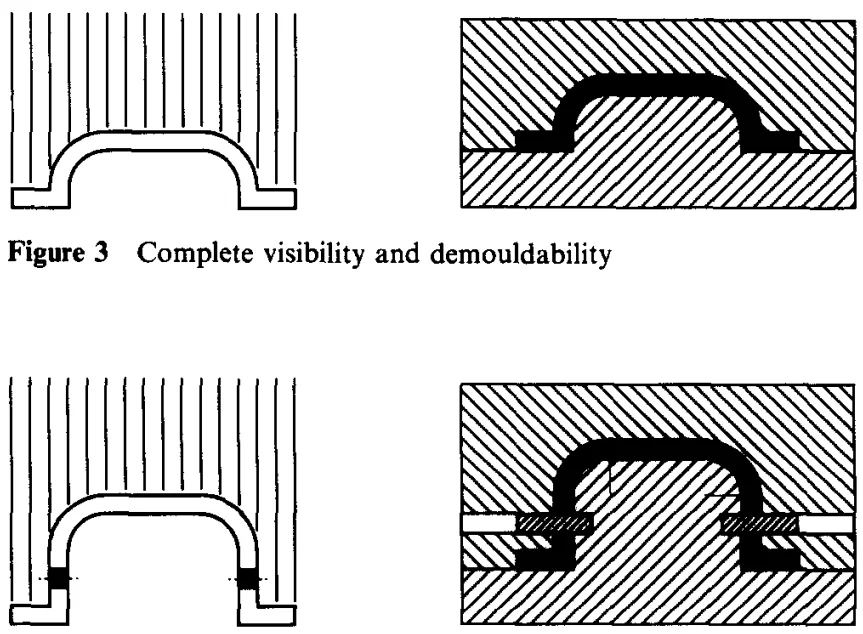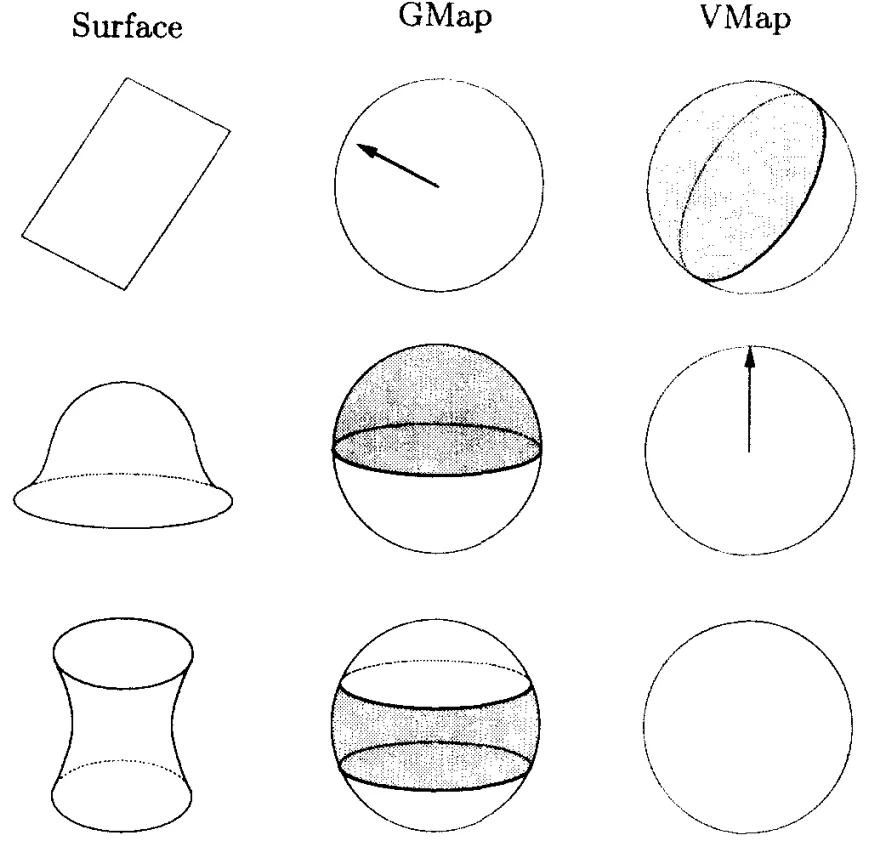This technical brief is based on the academic paper "Parting directions for mould and die design" by Lin-Lin Chen, Shuo-Yan Chou, and Tony C. Woo, published in Computer-Aided Design (1993). It is summarized and analyzed for HPDC professionals by the experts at CASTMAN.

Keywords
- Primary Keyword: Parting Direction Optimization
- Secondary Keywords: Die Casting, Injection Moulding, Mould Design, Undercuts and Cores, Computational Geometry, Visibility Map, Demouldability
Executive Summary
- The Challenge: Selecting the best parting directions for a mould is a critical design step. A non-optimal choice leads to more undercuts, requiring complex and costly cores that slow down production and increase tooling expenses.
- The Method: The researchers developed a deterministic algorithm using computational geometry. This method analyzes the 3D model of a part, identifies all possible demoulding directions for each feature, and represents them as "visibility maps" on a sphere.
- The Key Breakthrough: The paper presents a systematic algorithm that can mathematically determine the single best pair of parting directions to minimize the number of required cores, moving beyond traditional trial-and-error or heuristic methods.
- The Bottom Line: By applying this geometric algorithm, manufacturers can reduce tooling costs, simplify mould construction and operation, and shorten the production cycle.
The Challenge: Why This Research Matters for HPDC Professionals
In die casting and injection moulding, the selection of parting directions is a foundational step that influences the entire manufacturing process.. A moulded part must be easily ejected from the two halves of the mould. Any recesses or projections, known as undercuts, prevent this straight-line removal and necessitate the use of side cores, pins, or inserts.. While necessary, these mechanisms add significant cost, complicate the mould's design and operation, and reduce the overall production speed..
For decades, engineers have often relied on experience, heuristics, or simplified assumptions—such as restricting parting directions to the three principal axes—to make this critical decision. [6-8]. The drawback of these approaches is the uncertainty; it's impossible to know if a better solution exists or, in some cases, if a feasible direction can be found at all.. This research tackles the problem head-on by developing a deterministic method to find the provably optimal pair of parting directions.
The Approach: Unpacking the Methodology
To find the optimal parting directions, the researchers developed a novel approach grounded in computational geometry. The core principle is "demouldability," which is directly related to the concept of "complete visibility." A surface is considered demouldable along a specific direction if it is completely visible from that direction, meaning no part of the object itself blocks its removal.
The methodology involves three key steps:
- Decomposition into Pockets: The algorithm first analyzes the geometry of the object and decomposes it into a set of "pockets." A pocket is a recess or feature that may contain undercuts (Figure 6).
- Visibility Map (VMap) Generation: For each pocket, the researchers compute a "visibility map" (VMap), which is a unique spherical region representing the set of all possible directions from which that specific pocket is completely visible and thus demouldable without a core (Figure 9).
- Optimal Direction Search: The problem is then transformed into a geometric search. The algorithm seeks to find a pair of opposite points (representing the parting directions) on the sphere that are contained in, or "cover," the maximum number of these VMaps. The pockets whose VMaps are not covered are the ones that will require cores.
The Breakthrough: Key Findings & Data
The primary breakthrough of this paper is the development of a robust algorithm that guarantees finding the optimal parting directions to minimize core usage. The algorithm effectively translates a complex manufacturing problem into a solvable geometric one.
- Finding 1: A Deterministic Solution: The research moves beyond guesswork. The algorithm provides a definitive answer by systematically partitioning all possible directions and identifying the pair that covers the most geometric features, as illustrated by the spherical partition in Figure 10.
- Finding 2: Minimizing Cores through Geometric Coverage: The study shows that the number of required cores is directly related to the number of pockets whose VMaps are not covered by the chosen parting directions. By finding the directions that cover the maximum number of VMaps, the algorithm inherently minimizes the number of cores. For example, in Figure 10, direction
dand its opposite cover pockets S₁, S₂, and S₄, leaving only S₃ to be formed by a core. - Finding 3: An Efficient Algorithm: The authors developed an algorithm with a time complexity of O(nm log m) for an object with m pockets and n vertices. This makes the approach computationally feasible for analyzing complex industrial parts.
Practical Implications for Your HPDC Products
Based strictly on the paper's results and conclusions, this research has direct and valuable implications for modern manufacturing operations.
- For Die Design: This study provides a powerful analytical tool for the die design stage. Instead of relying on intuition, designers can use this algorithmic approach to analyze a part's geometry and definitively identify the optimal parting strategy before cutting steel. This can prevent costly redesigns and the creation of unnecessarily complex and expensive tooling.
- For Process Engineers: The findings in the "Parting Directions" section suggest that a computationally-driven choice of parting direction can directly minimize the number of cores. This simplifies the mould's mechanical action, potentially reducing cycle times, lowering the chance of mechanical failure, and streamlining the entire production process.
- For Cost Estimation: The ability to determine the minimum number of required cores at the design stage allows for more accurate and competitive quoting. By understanding the true complexity of the required tooling early on, you can avoid unforeseen costs and delays.
Paper Details
Parting directions for mould and die design
1. Overview:
- Title: Parting directions for mould and die design
- Author(s): Lin-Lin Chen, Shuo-Yan Chou, and Tony C. Woo
- Year of publication: 1993
- Journal/academic society of publication: Computer-Aided Design, Volume 25, Number 12
- Keywords: manufacturing, algorithms, computational geometry, injection moulding, die casting, parting directions, visibility
2. Abstract:
On the basis of the condition for demouldability, two levels of visibility, complete and partial visibility, are defined. The viewing directions from which a surface is completely visible can be represented as a convex region on the unit sphere called the visibility map of the surface. Algorithms are given for dividing a given object into pockets, for which visibility and demouldability can be determined independently, for constructing visibility maps, and for selecting an optimal pair of parting directions for a mould that minimizes the number of cores. An example illustrates the algorithms.
3. Introduction:
In die casting and injection moulding, a basic mould consists of two plates that separate along a pair of opposite parting directions. [1-4]. Features on the part that prevent its removal, called undercuts, require the use of cores, which increase tooling costs and complicate the process.. The paper notes that previous automated methods were limited, often assuming parting directions along principal axes or using heuristics, without knowing if a better solution exists. [6-10]. This paper presents a deterministic method to find an optimal pair of parting directions that minimizes the number of cores.
4. Summary of the study:
Background of the research topic:
The selection of parting directions is a critical step in mould design that dictates the number and shape of cores needed. Minimizing cores is a general rule to reduce cost and complexity..
Status of previous research:
Past approaches to automating this step were limited. They either restricted the choice of parting direction to a few principal axes, selected from random directions, or used heuristics. [6-10]. These methods could not guarantee finding a feasible, let alone optimal, solution.
Purpose of the study:
To develop a deterministic method for finding an optimal pair of parting directions for a given object's geometry, with the goal of minimizing the number of required cores.
Core study:
The core of the study is the formulation of the parting direction problem as a geometric problem of "spherical polygon covering by antipodes." The researchers developed an algorithm that decomposes an object into pockets, computes their visibility maps (VMaps), and finds a pair of opposite directions that covers the maximum number of these VMaps, thus minimizing the need for cores.
5. Research Methodology
Research Design:
The study uses a theoretical, algorithmic approach based on computational geometry. It defines demouldability in terms of "complete visibility" from a viewing direction. An object is decomposed into disjoint "pockets," for which visibility can be processed independently.
Data Collection and Analysis Methods:
The method involves mapping the visibility of each pocket onto a unit sphere, creating a "visibility map" (VMap). The problem is then solved by finding a point on the sphere that is contained within the maximum number of these VMaps. An algorithm is presented to compute the spherical partition induced by the VMaps and traverse it to find the optimal point (direction).
Research Topics and Scope:
The research focuses on polyhedral objects and aims to find a single pair of optimal parting directions. It assumes that the primary goal is to minimize the number of cores, treating all cores as equally undesirable.
6. Key Results:
Key Results:
The main result is an O(nm log m) time algorithm for determining the optimal parting directions for an object with m pockets and n vertices. This algorithm guarantees a solution that minimizes the number of required cores based on the part's geometry. The paper provides a step-by-step example (Figure 6, 9, 10) to illustrate how the algorithm identifies optimal directions by finding a maximally covered point on a spherical partition.
Figure Name List:



- Figure 1: Example of mould and corresponding parting directions
- Figure 2: Example of object requiring side core for external recess
- Figure 3: Complete visibility and demouldability
- Figure 4: Partial visibility and use of cores
- Figure 5: Examples of surfaces and their corresponding GMaps and VMaps
- Figure 6: Object; (a) object, (b) its convex hull, (c) corresponding sealed pockets, (d) pockets
- Figure 7: Spherical polygon covering by antipodal points
- Figure 8: Two adjacent cells and their ownership vectors
- Figure 9: Pockets of object in Figure 6 and their corresponding VMaps
- Figure 10: Spherical partition induced by VMaps in Figure 9 and their opposites
7. Conclusion:
An O(nm log m) time algorithm was developed to determine optimal parting directions to minimize cores. The paper notes that the algorithm can be modified to assign different weights to different pockets based on complexity or cost. A stated assumption is that a core is used for any pocket that is not fully visible. The authors suggest that future work could explore subdividing pockets to further eliminate cores by invoking partial visibility.
8. References:
- Bralla, J G (Ed.) Handbook of Product Design for Manufacturing: A Practical Guide to Low-Cost Production McGraw-Hill (1986)
- Campbell, J Castings Butterworth-Heinemann (1991)
- Pye, R G W Injection Mold Design: A Textbook for the Novice and a Design Manual for the Thermoplastics Industry (4th Ed.) John Wiley (1989)
- Rubin, I I Handbook of Plastic Materials and Technology John Wiley (1990)
- Kalpakjian, S Manufacturing Processes for Engineering Materials Addison-Wesley (1991)
- Lee, K and Smith, C T 'Computer-aided pattern design for casting processes' Manufacturing Processes, Systems & Machines Proc. 14th Conf. Production Research & Technology (1987) pp 365-371
- Ravi, B and Srinivasan, M N 'Decision criteria for computer-aided parting surface design' Comput.-Aided Des. Vol 22 No 1 (1990) pp 11-18
- Smith, C T and Lee, K 'Computer-aided pattern design for casting processes' AFS Trans. (1986) pp 21-28
- Ganter, M A and Tuss, L L 'Computer-assisted parting line development for cast pattern production' AFS Trans. (1990) pp 795-800
- Hui, K C and Tan, S T 'Mould design with sweep operations - a heuristic search approach' Comput.-Aided Des. Vol 24 No 2 (1992) pp 81-91
- O'Rourke, J Art Gallery Theorems and Algorithms Oxford University Press (1987)
- Toussaint, G T 'Computing visibility properties of polygons' in Pattern Recognition and Artificial Intelligence North-Holland (1988)
- Stolfi, J Oriented Projective Geometry: A Framework for Geometric Computations Academic Press (1991)
- Struik, D J Lectures on Analytic and Projective Geometry Addison-Wesley (1953)
- Hilbert, D and Cohn-Vossen, S Geometry and the Imagination Chelsea (1952)
- Chen, L L and Woo, T C 'Computational geometry on the sphere for automated machining' ASME J. Mech. Des. Vol 114 No 2 (1992) pp 288-295
- Hoffmann, C M Geometric and Solid Modeling: An Introduction Morgan Kaufmann (1989)
- Edelsbrunner, H Algorithms in Combinatorial Geometry Springer-Verlag (1987)
- Preparata, F P and Hong, S J 'Convex hulls of finite sets of points in two and three dimensions' Commun. ACM Vol 2 No 20 (1977) pp 87-93
- Tang, K and Woo, T C 'Algorithmic aspects of alternating sums of volumes. Part 1: Data structure and difference operation' Comput.-Aided Des. Vol 23 No 5 (1991) pp 357-366
Expert Q&A: Your Top Questions Answered
Q1: What was the single most critical factor identified in this study for minimizing cores?
A1: The study concluded that the most critical factor is finding a pair of antipodal parting directions (p and -p) that are contained in the maximal number of visibility maps (VMaps). This ensures the highest number of part features can be demoulded without requiring a core. [Parting directions for mould and die design, "Parting Directions" section, Figure 7].
Q2: How does this research compare to traditional methods for addressing the problem?
A2: The paper's Introduction notes that traditional methods often rely on heuristics or are restricted to testing only the three principal axes. [6-8]. This research introduces a deterministic algorithm that analyzes all possible directions and guarantees finding an optimal solution, which is a significant improvement over the uncertainty of previous approaches. [Parting directions for mould and die design, "Introduction" section].
Q3: Is this finding applicable to all types of alloys, or a specific one?
A3: The research is purely geometric and focuses on the shape of a "polyhedral object." It is independent of the material. Therefore, the algorithm is applicable to the geometry of any part, regardless of the specific alloy being cast. [Parting directions for mould and die design, "Visibility and Demouldability" section].
Q4: What specific technique did the researchers use to arrive at this conclusion?
A4: The researchers utilized computational geometry techniques. Specifically, they modeled the problem by creating "visibility maps" (VMaps) for part features on a Gaussian sphere and then developed an algorithm for "spherical polygon covering by a point" to find the optimal directions. [Parting directions for mould and die design, "Algorithm (spherical polygon covering by a point)" section].
Q5: According to the paper, what is the main limitation or area for future research?
A5: The authors state in the Conclusion that a key limitation is the assumption that all cores are equally undesirable. They suggest future work should focus on modifying the algorithm to handle weighted pockets based on cost or complexity, and to explore how subdividing a pocket might eliminate the need for a core entirely. [Parting directions for mould and die design, "Conclusions" section].
Q6: What is the direct, practical takeaway from this paper for a die casting facility?
A6: The core takeaway is that by using a computational algorithm to analyze a part's geometry, it is possible to determine the optimal parting directions that will definitively minimize the number of cores. This leads directly to reduced tooling costs, simpler moulds, and more efficient production cycles. [Parting directions for mould and die design, "Conclusions" section].
Conclusion & Next Steps
This research provides a valuable roadmap for enhancing mould design in HPDC. By moving from heuristic-based decisions to a data-driven, geometric algorithm, the findings offer a clear path toward improving quality, reducing tooling costs, and optimizing production.
At CASTMAN, we are dedicated to applying the latest industry research to solve our customers' most challenging die casting problems. If the issues discussed in this paper resonate with your operational goals, contact our engineering team to discuss how we can help you implement these advanced principles in your components.
Copyright
- This material is a paper by "Lin-Lin Chen, Shuo-Yan Chou, and Tony C. Woo". Based on "Parting directions for mould and die design".
- Source of the paper: Computer-Aided Design, Volume 25, Number 12, December 1993. A specific DOI URL is not provided in the document.
This material is for informational purposes only. Unauthorized commercial use is prohibited.
Copyright © 2025 CASTMAN. All rights reserved.